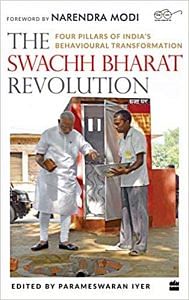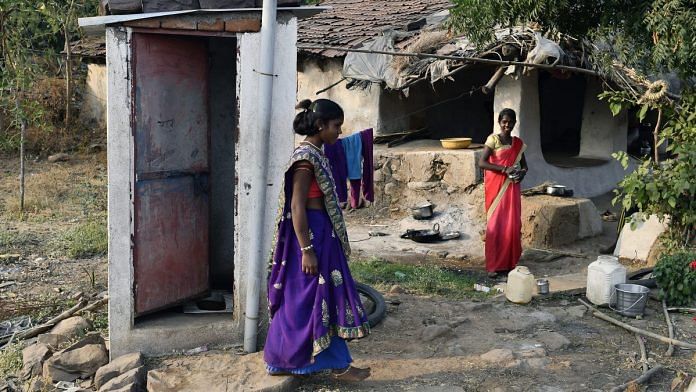A half-empty glass versus a glass half-full – it’s a cliché. Typically, where is the glass located when you glance at it? More often than not, it is on a table of some sort, below your line of vision. Therefore, your eye focuses on the empty bit. I wonder how we would react if the glass were placed above our line of vision, so that we looked, at it from the bottom, rather than the top. This strikes me as an apt analogy because of a recent incident.
An acquaintance had dropped in, to complain and lament about cabbages and kings. This was the time of the year when assorted diaries find their way on to my desk. Increasingly, people don’t use such diaries, but old habits die hard. A beautiful diary (and an accompanying calendar) brought out by the Ministry of Drinking Water and Sanitation, with a focus on the Swachh Bharat Mission (SBM), especially its Grameen (rural) part, lay on my table. SBM was started on 2 October 2014. A little bit about SBM’s dashboard first. Since October 2014, 92.5 million toilets have been constructed and 157.3 million rural households have toilets as of June 2019, that is 99.08 per cent of rural households.
Just so one has a sense of what this entails, when SBM started, the coverage was 38.70 per cent. Goa and Odisha are the only two states that lag by a bit as I write this; for Odisha, as is only to be expected, there are disparities between districts. Some districts like Kalahandi, Mayurbhanj, Kendrapara, Malkangiri and Nayagarh p;ull the state down. Barring these two states, IHHL (individual household latrine application) coverage in all states is in excess of 95 per cent. By October 2019, coverage should be universal. Whichever way you look at it, this is nothing short of a revolution.
Also read: Modi govt’s Swachh Bharat achieved one thing. And it’s not open defecation free India: Survey
All this has a bearing on Sustainable Development Goal 6.2: ‘By 2030, achieve access to adequate and equitable sanitation and hygiene for all, and end open defecation, paying special attention to the needs of women and girls and those in vulnerable situations.’ Often, in scenarios where open defecation figures prominently and many households are mentioned as not having access to toilets, one finds references to India. For instance, World Bank reports for 2015 note that 40 per cent of the Indian population resorts to open defecation. This is an official World Bank figure.
A December 2018 paper, co-authored by World Bank researchers, states, ‘A staggering 48 per cent of Indians continue to defecate in the open despite large-scale efforts from the government to raise awareness about the harmful aspects of open defecation and subsidize latrine construction, and growing latrine ownership. This is a formidable challenge since almost 70 per cent of rural Indian households currently do not have access to improved sanitation facilities.’
Whom do we believe? Numbers like those from the World Bank or the SBM dashboard? Both propositions are true. The reason for apparently contradictory numbers is obvious – cross-country data quoted is often for 2015. And since 2 October 2014, a silent revolution has changed this aspect of rural India. A pity it is silent, a pity it is not recognized much more, a pity cross-country numbers aren’t updated sufficiently quickly.
As of June 2019, 618 districts, 6,029 blocks, 2,47,640 gram panchayats and 5,62,000 villages have been declared Open Defecation Free (ODF). A declaration means nothing. Shouldn’t there be some verification? Precisely. Out of the 5,62,000 villages declared ODF, 4,94,625 have been verified to be ODF. So what? Toilets have been built. However, households don’t use them. Perhaps the toilets don’t have water. Perhaps a village is declared ODF, but slips back. These are legitimate questions to ask. And the only way to answer these questions is through a survey. The second National Annual Rural Sanitation Survey (NARSS 2018–19) was conducted by an independent verification agency between November 2018 and February 2019 as part of the World Bank support project to SBM-G. (There was an earlier survey in 2017–18.) NARSS 2018–19 results are still provisional, they have to be finalized.
Nevertheless, the provisional results are quite a revelation and need much greater dissemination. As per the survey findings, 93.1 per cent of rural households have access to toilets; 96.5 per cent of people who had access to toilets used them; 90.7 per cent of verified ODF villages were confirmed as ODF. In passing, 95.4 per cent of villages had minimal litter and stagnant water. For the record, these numbers are better than those in NARSS 2017–18. I must confess, they are far better than what I would have expected a priori. Using the glass image, there is some emptiness, but it is a sliver. There is some slippage, but not as much as one might have thought. I am inclined to think the glass is much more than half-full. It is pretty close to being full-full.
So that one is methodologically clear about what this survey entails, ‘An ODF-verified village is confirmed to be ODF if, during the survey, it is found that: All households and all public institutions surveyed are found to be using safe technology for disposal of feces and no visible feces found in the village surroundings.’ A village may not be confirmed as ODF because of any of the following reasons. ‘1. Lower than 100 per cent access to toilets in the village; 2. Presence of unhygienic/dysfunctional/unsafe toilet in any household in the village; 3. Non-usage of a toilet by the household members; 4. Non-access of a toilet in schools or anganwadis; 5. Presence of visible fecal matter in the village.’
Sure, this is a survey and not a census. Even in an ODF confirmed village, a media report may appear about some household resorting to open defecation, or not using a toilet. That’s neither here nor there. Within the parameters of a survey, such improvements boggle the mind.
Such revolutionary changes don’t occur merely because the Union or state governments decide to take some action. At best, governments can only be a trigger, a catalyst. Behavioural change confronts the bane of inertia, reminding us of Newton’s Second Law of Motion. We do need an external stimulus to change the state. That might be through films like Toilet: Ek Prem Katha, Halkaa or Gutrun Gutargun. Or that change might come from swachhagrahis.
The diary I mentioned has twelve lovely cartoons. One of these is on swachhagrahis. The diary tells us ‘Swachhagrahis are the foot soldiers of the Swachh Bharat Mission. Over the last four years, a cadre of over 5,00,000 swachhagrahis has been created who have triggered lakhs of villages to become ODF.’ My acquaintance hadn’t heard of swachhagrahis until he flipped through the diary on my table. He was so engrossed in lamenting about interest/exchange rates, ships and sealing wax that he, like many citizens of urban India, had failed to notice a silent revolution sweeping through rural India.
Let me quote from the August 2018 circular on revised guidelines for swachhagrahis. ‘As you are aware, Swachh Bharat Mission (Grameen) [SBM-G] emphasises on intense behaviour change campaigns including inter-personal communication for achieving sustainable sanitation outcomes. Swachhagrahis are the foot soldiers of SBM-G and the motivators for bringing about behaviour change with respect to key sanitation practices in rural areas.
Role of swachhagrahis is one of the key factors in achieving the ODF status and sustaining it through post ODF activities. A swachhagrahi is a volunteer who can come from any background, including a local ASHA worker, ANM, anganwadi worker, and staff, water line man, pump operator, member of NCO/CSOs, youth organisations or from the general public living in villages.’ Beyond the obvious, there are several things swachhagrahis do – geo-tagging toilets, verifying household behaviour, converting old toilets and retro-fitting them, and engaging in other forms of cleanliness.
Also read: Modi govt’s Swachh Bharat shows why switching to ‘mission mode’ is helping India
In April 2018, the Prime Minister addressed a national convention of swachhagrahis – as part of the Satyagraha Se Swachhagraha programme – and gave awards to ten outstanding performers. Indeed, they are the ones who provide the drive to SBM. They are the ones who have raised the level of the table. We can look at the glass from below and not from the top and say, ‘The glass is full’.
 This excerpt from The Swachh Bharat Revolution: Four Pillars of India’s Behavioural Transformation, edited by Parameswaran Iyer, has been published with permission from HarperCollins India.
This excerpt from The Swachh Bharat Revolution: Four Pillars of India’s Behavioural Transformation, edited by Parameswaran Iyer, has been published with permission from HarperCollins India.




People continue to defecate openly in the heart of the National Capital in the Chanakyapuri area, a posh diplomatic area debunking the claims of ODF free india.